Media | Articles
Our tame fighter pilot “don’t look like a trucker” and “don’t smell like a trucker”
Have you ever felt totally out of place? Maybe you were in a spot that isn’t your scene, as they say? In that moment, did it seem like everyone could see right through you and they knew you didn’t belong? It sure feels that way to me.
I don’t consider myself superstitious. There’s not a special sports jersey I wear when my team is playing, I had a child born on a Friday the 13th so the calendar doesn’t bother me, and broken mirrors/black cats/walking under ladders aren’t a thing for me. That said, in all my years of flying, I’ve only had my wife (with or without our kids) watch me take off once or twice. The odds of something catastrophic happening on takeoff are really small (thankfully), but I figure those odds get worse when loved ones are present. It’s one thing to become a giant, smoking hole. It’s quite another to do so in front of family.
For those of you who are new here, this piece is part of a series from “Josh Arakes,” a senior U.S. military fighter-jet pilot who has obtained permission to share some of his life and experiences with us here at Hagerty. If you want to hear more about the Top Gun lifestyle, both as it relates to jets and cars, please let us know in the comments or by emailing tips@hagerty.com. Josh is willing to tell us anything that doesn’t compromise operational security. Enjoy! —Ed.
Prior to taking off, a ground crew will look over each jet for leaks or anything amiss (some call this “last chance”). As part of that final check, weapons troops will arm up any munitions and ensure pylons are able to jettison any stores in the event of an emergency. Near that area on the airfield can be a pretty good spot for guests to observe the jets and watch the takeoffs, though getting access with a proper escort can be a tall order in many places.
Some fighter jets only have single-seat versions (F-35, for example); others, like the F-18, have trainer variants in which an instructor sits in the back seat for a few sorties until the student is cleared to fly sans instructor. Regardless, during the months-long initial training, if there’s not an instructor physically in the aircraft, there’s one in the aircraft next to you.
Marketplace
Buy and sell classics with confidence

I clearly remember one of my very first sorties without an instructor sitting in the rear seat of my fighter jet. We were both going through this “last chance” inspection and arming, which can take several minutes depending on how many jets are ahead of you and the number/type of munitions being carried (and whether or not any problems are discovered). On this particular day there was a group of 10-15 people observing the inspections and arming, though they were more interested in the takeoffs that followed. And with good reason: There’s not a bass drop in the world’s entire musical archive, to include the complete Rick Astley discography, that compares to watching fighter jets take off at close range. As the jets in front of us left the arming area and slipped the surly bonds of earth, we filled in the empty spots near the group whereupon they started taking pictures of us and our jets.
I couldn’t help but realize they thought we were super cool, yet they had no idea how hard I was working to not expose my idiocy and cluelessness; I was, figuratively, hanging onto the jet’s tail for dear life and I hadn’t even taken off yet. If they had been able to see the giant red clown nose and clown shoes I felt like I was wearing, they would understand I was anything but cool and collected. They’d wonder how I’d convinced anybody to let me anywhere near such a magnificent machine, let alone pilot it.

As the years passed and my experience in fighters grew, I still had to work to stay ahead of the jet but I shed my metaphoric clown nose and shoes. (Well, mostly shed, anyway; few things can humble you like missing a target or blowing an assignment that leads to the simulated deaths of your buddies.) I had proven myself to my peers over years of flying, hundreds of sorties, combat missions, and multiple assignments, so I knew I belonged.
It’s in the space between assignments where I still feel the struggle to fit in. Moving is a regular occurrence for military families, though we’ve moved more than most. Our three high school graduates lived in 16, 14, and 11 houses/apartments before moving out of the house. When it’s time to move, the military will pay movers to pack up and move your stuff. Each military member is given a weight allowance based on their rank and whether or not they have dependents (not the number of dependents they have, just on whether or not they have any). If the weight allowance is exceeded the military member can be responsible for the excess costs.
My wife and I have five children. Strangely enough, they each wanted their own bed, dresser, clothes, etc; kids these days, amirite? Add in my tools, all our books (last count was over 1200), and my classically-trained musician wife’s collection of instruments (to include an 800-pound baby grand piano), and we blew past our weight allowance lo these many years ago. Fortunately, there’s an option to do all or part of the move yourself, for which the military will reimburse you.

A Do-It-Yourself (DITY) move, now called a Personally Procured Move (PPM) for some unknown reason, can be advantageous to both the military and the member. Generally, the military pays the member 95 percent of what they’d pay a mover (though the percentage does occasionally vary), and the member can choose to do a partial DITY and, for example, be paid only for the luggage in their vehicle, or go nuts and do the entire thing solo (if you, either by yourself or in conjunction with movers, move more than your weight allowance you are only reimbursed up to said allowance). It’s possible to even make some money—potentially a few thousand dollars after expenses and taxes—but it certainly takes way more effort than watching movers do all the work for you.
Several moves ago I realized we were pushing our weight limit. I managed to convince my wife to do a partial DITY by filling an entire moving truck, thereby potentially making a little money while also not suffering charges for going over our weight allowance. We did these one-truck moves on two separate occasions before I thought we should just do the whole thing ourselves. Only after we decided what we would put the money towards did my wife acquiesce to undertaking a full DITY (for reference, on our most recent move we had 24,000 pounds of stuff, many thousands of pounds over our weight limit).
And that’s how I became a poseur truck driver.
Over the course of four moves, I’ve driven a 26-foot Penske truck, towing a car trailer, more than 12,000 miles. I’ve learned a lot of hard lessons, been to a lot of truck stops, and spent more time than I care to remember crawling up freeway inclines at school-zone-legal speeds.
My first attempt at truck driving teetered frequently on the ragged edge of disaster. We had movers load up about half of our stuff; we sent the awkwardly shaped and light items with them and saved the dense items to go in our truck. As part of the paperwork, the military gives you an estimate of what they’ll pay you based on the weight estimate you give them. My brain naturally breaks that down into dollars per pound, meaning it’s easy to fall into the trap of looking at heavy furniture, seeing dollar signs, and then overloading the truck.
And so it was that I found myself on a Friday afternoon at a truck scale trying to convince myself it wasn’t a bit deal that the weighmaster just handed me a ticket saying my full truck weighed 24,000 pounds when the driver’s side door of my truck had a notice that read “GVW Under 20,000 pounds.” On my 20-minute drive to our now-empty home, having noticed the truck did possess a curiously high center of gravity, I decided that although the truck was sure to have a safety margin in terms of what it could actually carry relative to what it was rated to carry, a 20-percent margin seemed a little high. Not to mention what weigh stations across eight states would say when I rolled in carrying the equivalent of two extra GBU-31 JDAMs.
A quick search told me that Penske had a larger truck that was available in my area, so I made the reservation to swap trucks. I called the moving company that loaded our military goods and got a couple of their guys to agree to meet me the next day to help transfer our 10,000 pounds of household goods from one truck to the other. I got the two trucks back-to-back and we extended the loading ramp of one truck to the cargo area of the other so we could move items gangplank-style without having to walk down one ramp and up the other. A couple hours later I was a few hundred dollars poorer, but also legal and safely loaded, and thus ready to drive by majestic purple mountains and fruited plains en route to our new home.
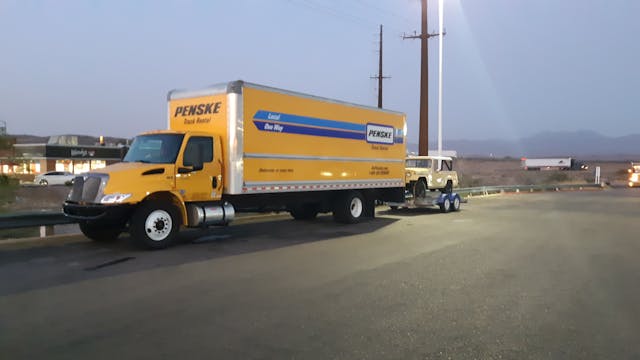
For some reason I thought it would be prudent to make the 2000+ mile drive in three days while towing the Jeepster on a car trailer (I don’t think I realized that I wouldn’t be cruising at 80 mph the entire time as I would in a car). Traffic was terrible on day one, and late at night, desperately needing food, I made a rookie move and pulled into a fast food restaurant’s parking lot. There, an inattentive driver forced me to pull into a small section of the parking lot to avoid hitting them. Long story short, I was unable to turn around, and without a spotter to help me back out, it took 20 minutes to work my 55-foot long truck and trailer combo out of the small lot without incident. I skipped getting food in the end and hopped back on the road, patience exhausted and still over an hour from the hotel.
Once I got there, the combination of my cluelessness and tiredness caused me to once again get stuck, this time in a small section of the hotel’s parking lot. The awning over the hotel entrance was lower than the truck’s height, which is why I now scout my prospective hotel parking lots on Google Maps and avoid hotels with crappy parking layouts. As I tried to back my way out, the trailer tire caught a curb and popped the weld on the trailer’s tongue, destroying it. I unloaded the Jeepster, managed to back the barely-held-together trailer into a parking spot where I disconnected it before parking the truck. And collapsing into bed.
The next morning I called Penske, explained the situation, and within a couple hours they brought me a new trailer and used a wrecker to take the other one away (at no charge!). Hitting the road at noon with 800 miles in front of me, the day was miraculously event-free, a layer of delicious guacamole on an otherwise cold, stale poop sandwich of a journey.
I awoke on day three facing 700 miles of occasionally mountainous terrain before reaching my destination. I’d been averaging 8-10 mpg to this point, and there remained one final big climb. Eyeing my gas gauge, I knew I’d need to fill up on diesel before hitting the mountain and I’d seen a sign for a gas station a few miles up the road (I hadn’t yet internalized the rules to only use truck stops and fill up with no less than a quarter-tank remaining). Naturally, the gas station was closed (as in, windows were boarded up and parking lot was chained off) and there wasn’t anything for another 20 miles or so into the mountainous terrain. Without any other option, I crossed my fingers and headed off.

This is a good time to discuss the uncountable hours I’ve spent trying to decode the transmission’s shift algorithm in these Penske trucks. There are plenty of times that it just refuses to downshift while the truck drives uphill, leading me to try all manner of experimentation to please-for-the-love-of-all-things-good-on-this-green-earth get it to drop a gear. My conclusion? Short of coming to a dead stop, ill-advised for lots of reasons, there’s nothing you can do to outsmart Skynet. The transmission will shift when it feels like it.
Over the several-thousand-foot climb, I watched the needle on the gas gauge march inexorably towards empty. In flying, I’ve gotten really proficient at using lobster eyes—one eye on the airspeed and the other eye on the attitude indicator, for example—so simultaneously watching the road and gas gauge was easy. It quickly became apparent that I simply didn’t have enough gas. Some neuron buried deep inside my hippocampus remembered that running an engine out of diesel is way worse that running an engine out of gasoline. Still 5+ miles from the gas station, I pulled to the side of the road, afraid to go any farther on fumes. Head resting on steering wheel, I couldn’t help but think of Han Solo declaring, “No reward is worth this!”
At that dark moment, a bright light burst forth from the gloom: I remembered that not only was I towing a functional, drivable, newly-rebuilt Jeepster, but I had two empty 5-gallon gas cans in the Jeepster’s cargo area. All I had to do was unload the Jeepster, drive it to the gas station, fill up the cans with diesel, reload the Jeepster on the trailer, and like a modern day Ernest Shackleton, I’d rescue myself!

Walking back to unload the Jeepster, I noticed one of the trailer’s two passenger-side tires was shredded. Barely a thin ribbon of tire remained wrapped around the rim, and the other tire on that same side was nigh unto joining its compatriot in crossing over to the big tire mound in the sky.
Somehow, I had cell service. I called Penske (again) and they agreed to send someone to change the tires while I went and fetched some diesel. Not long after I returned, tire guy arrived, changed the two tires on the side of the road. Mad props to him, as the entire process looked miserable. Suddenly I was good to go, and my journey pressed on without further incident all the way to my destination. (Penske saved my bacon, again, at the palatable price of $0.00, again).
This is, I promise, not an ad for Penske. I chose that particular renter on this first big self-move because it had the bigger truck for less money than the other guys. The other times I’ve rented a moving truck since then, it’s always been Penske because of how well I was treated that first time, even though they haven’t necessarily been the cheapest for subsequent moves.
Fortunately for al parties, the other moving truck rentals I’ve experienced haven’t been nearly as memorable as that first trip. Admittedly, I had forgotten that first trip’s extreme level of heinousness. I just asked my wife how it was that we had continued to move ourselves across the country in light of its unparalleled awfulness. Bursting out laughing, she informed me I was not to ask her that question. She is awesome, infinitely patient, and so much more, but no aspect of packing, loading, and/or unloading moving trucks is appealing to her. Yet she humors me, and at this point the strategy is actually is starting to make some financial sense now that we know what we’re doing (not to mention how hard it was to get movers this summer).
The only other real truck issue we’ve had was during this summer’s move. In the absolute middle of nowhere, roughly 75 percent of the way through the first day’s drive, and with my wife caravanning behind me in the LX470 towing our trailer, I got a “Coolant level low” caution in my Penske. The truck dropped into limp mode, 25 miles away from any sign of civilization. With a top speed of about 50 mph (and a low of a scary 17 mph going up one particularly steep grade), we staggered to the first exit and pulled into a truck stop; I kept one of my lobster eyes on the temp gauge the entire time and it never budged (thankfully). I called Penske during the limping drive, got into the call-back cue, and my phone rang as we arrived at said truck stop. Penske offered to send somebody, and it would take an hour or so. Figuring my hack mechanic skills wouldn’t do me any good troubleshooting a modern diesel engine, I didn’t even bother opening the hood to see what was up. About an hour later the mechanic showed up, opened the hood, looked at the coolant reservoir, saw it was missing its lid and the coolant level was below the sensor, and said something to the effect of, “That’s your problem right there.”
I made the split second decision to not tell him that I write about cars as a side job.
He had a lid for the reservoir at his shop, nearby. Roughly twenty minutes later, reservoir filled and cap replaced, we were ready to hit the road again.
The truck stop, I noticed before we left, had a certified truck scale. (Weight tickets, full and empty, must be provided in order to receive reimbursement from the government for the move.) Knowing the Lexus and its trailer still needed to be weighed full of boxes, my wife went to take care of it. When she went inside to get the ticket, before she could say a word, the lady behind the counter looked at her and asked, “You need a weight ticket? Military move?” Stunned, my wife said that’s exactly what she needed. How did the lady know it was a military move, with no base within 100 miles of that truck stop? Looking around a little furtively, the lady told my wife, “You don’t look like a trucker and you don’t smell like a trucker.” At a loss for words, my wife thanked her, took the ticket, and drove back to the Penske.
I have no doubt the friendly mechanic, as well, took one look at me upon his arrival and knew I was no trucker.
In the years since I graduated from pilot training, my confidence in maneuvering massive machines loaded for bear has grown. I no longer carry my clown nose and shoes to the jet with the rest of my flight gear. But when I drive a 26-foot moving truck towing a car trailer, the clown nose and shoes are in the cab with me, if not on full display. I can’t say I know what a trucker looks like or smells like, but those who do sure can sniff out the pretenders.
They’re gracious, though. Truckers on the road and at stops have given poseur me and my Penske room to merge when I’ve needed it, and not yelled at me when I’ve failed to pull forward after filling the truck with diesel. For that, and for all the stuff truckers have delivered either to my house or the store from whence I bought it, I tip my hat. Thank you, and I wish to bless your travels with low diesel prices, short shower lines, and shallow inclines!
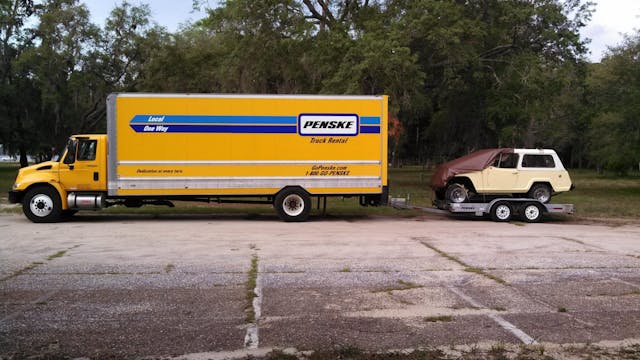






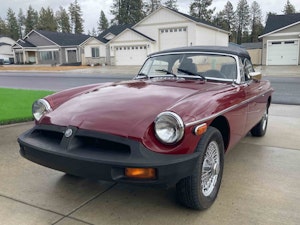

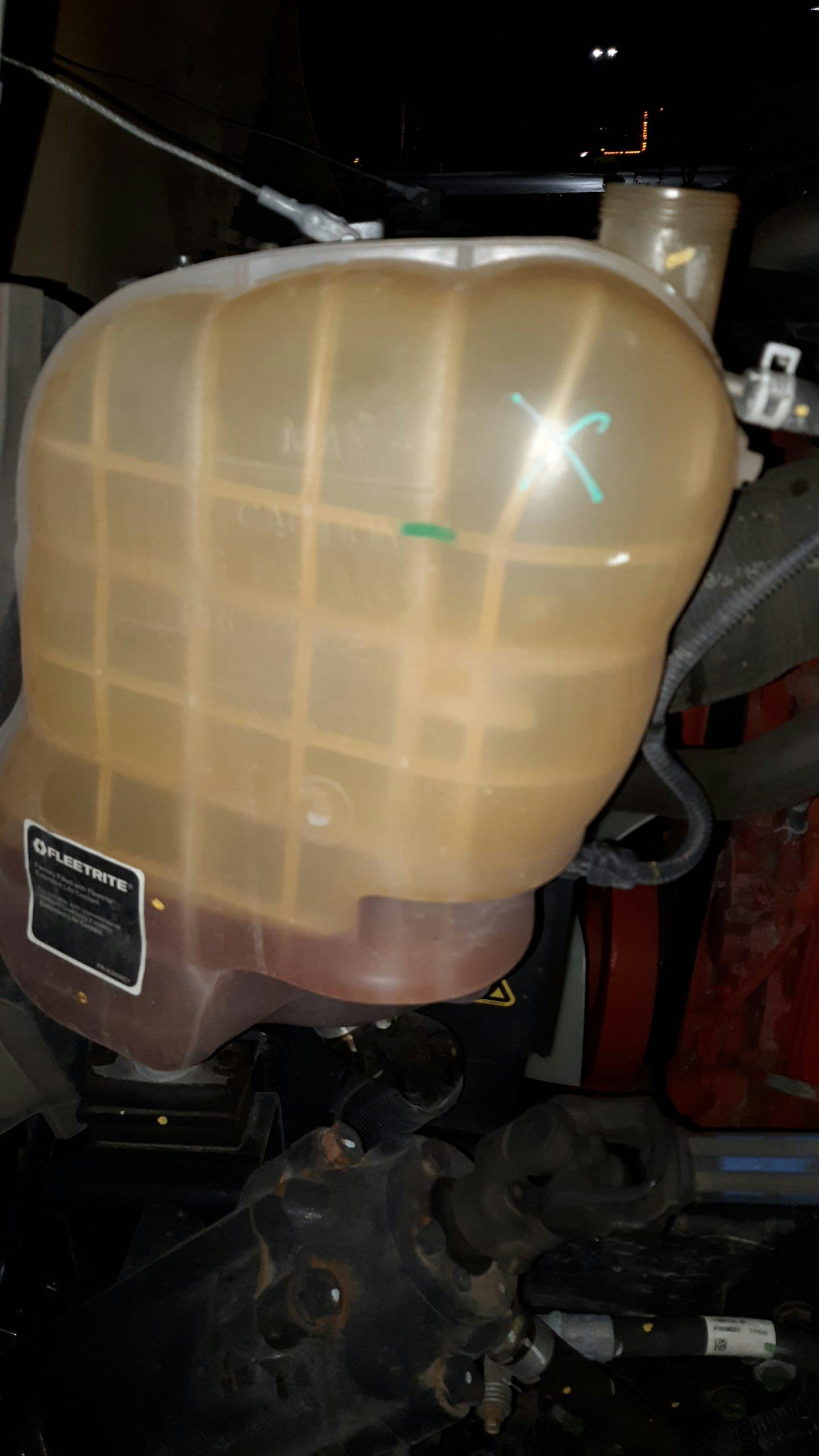
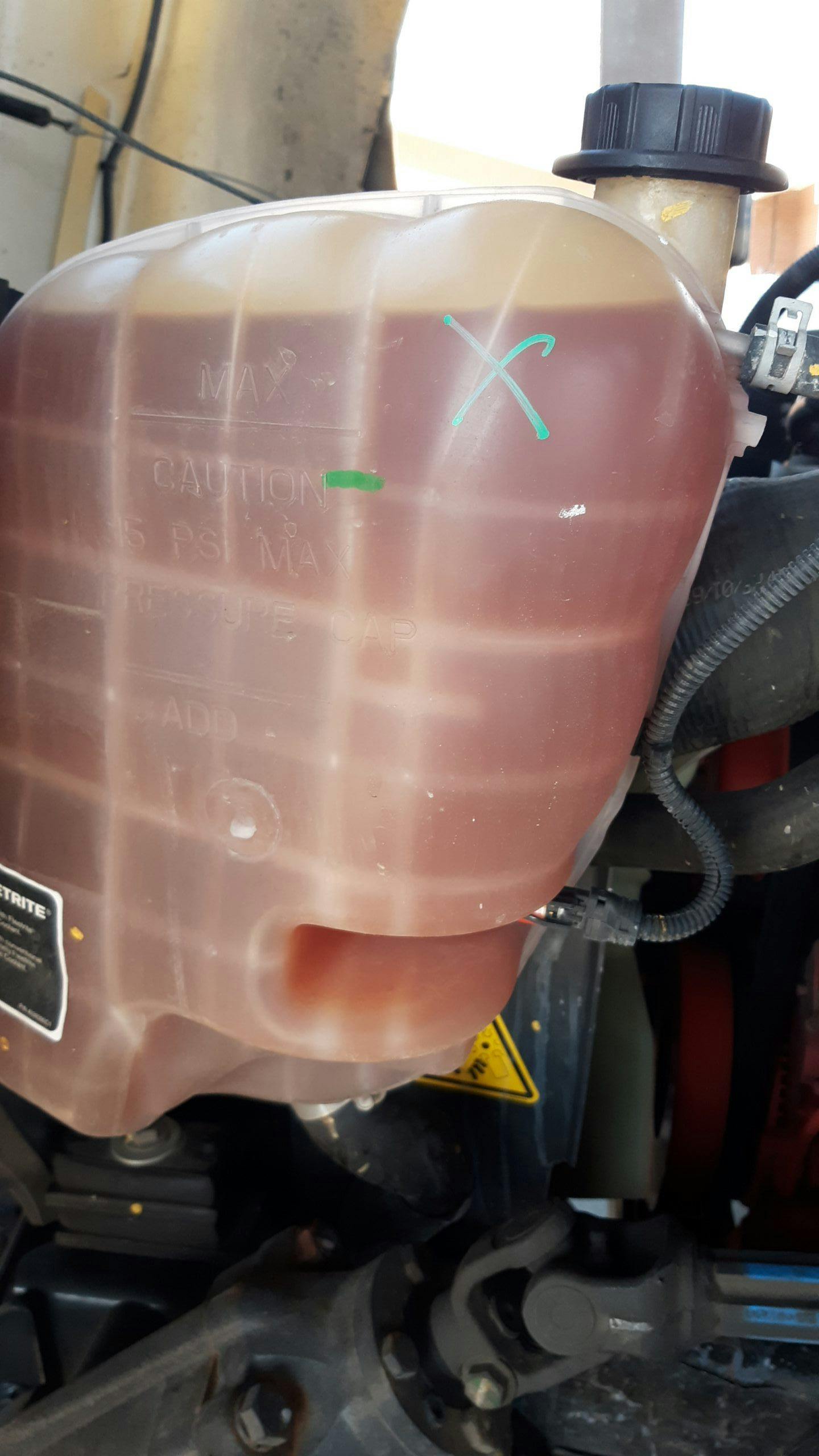










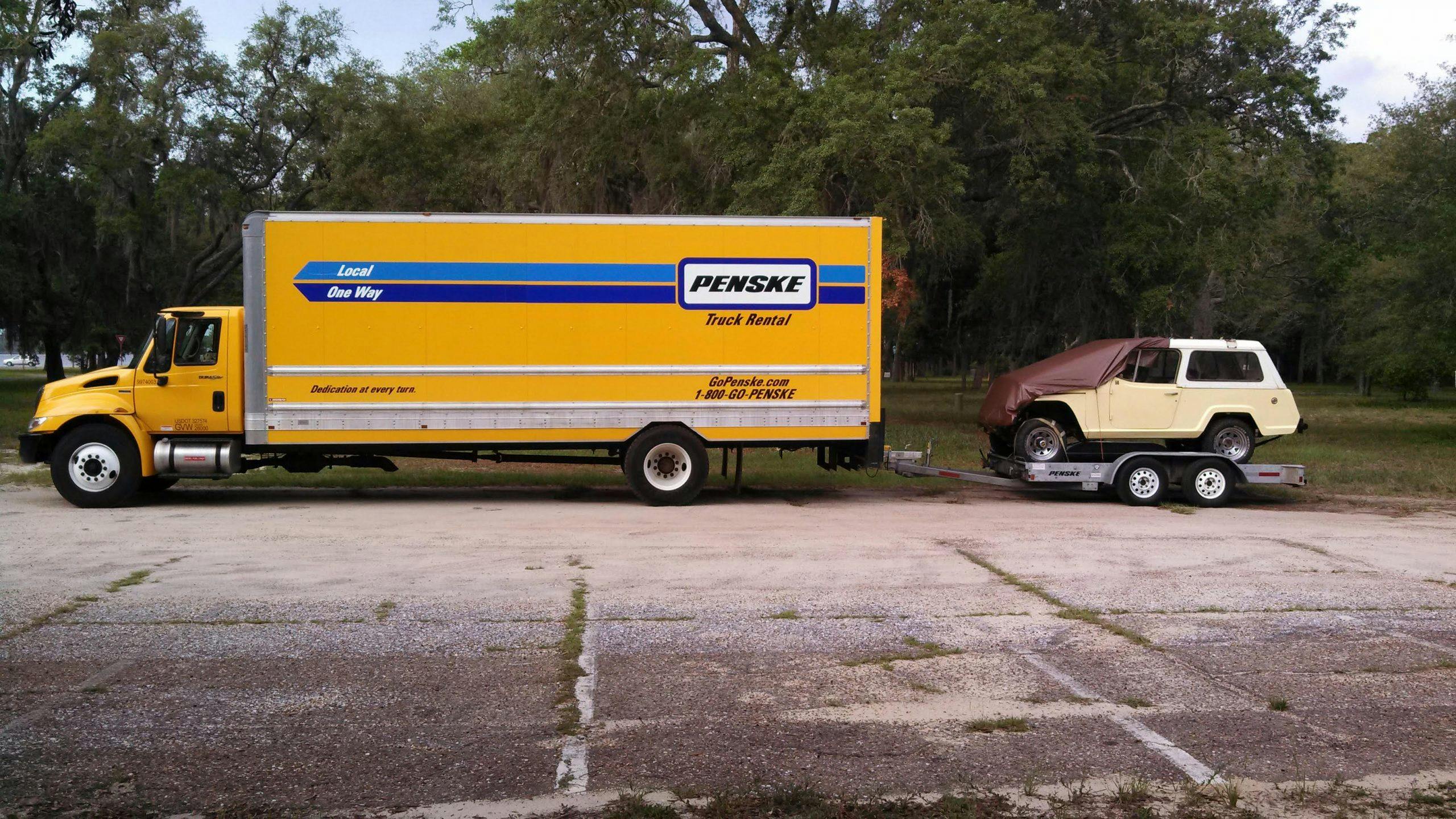
What a great story Josh. Wish I could write this good. I’m passing this story on to my 4 Grand kids, all in the military at the start of their careers. One Navy Aviator, one Navy submariner, one Marine and one in her senior year at Annapolis.
Best of luck to your grandchildren in their careers and their many moves! I hope they enjoy military life as much as I have.
Great story! Hagerty has had great content for a while now, but I’ve noticed that the volume of it has really ticked up lately. I hope it keeps up.
Thanks for reading and I’m glad you enjoyed it.
I’ve been reading your work since your first Hagerty appearance and have enjoyed every episode. You are an especially unusual combination: a versatile articulate thoughtful killer. We are all lucky you are in the sky defending us, for awhile longer, I assume.
You are very kind and I’m gratified to hear you enjoy my ramblings!
I was a trucker once – long ago. I remember one day as I was heading home, I chanced to hail a driver from my company on the CB – also headed home. This guy had been in trucks for 35 years, and had shown me more than just a few ropes in the two years I’d been working there. As we cruised down a nearly empty interstate, our discussion became more philosophical than might normally be heard on Channel 19 in those days. He complimented me on how far I’d come in my short time there, and said I was “someday going to be a fine truck driver”. I was a little taken aback – I thought I WAS a truck driver. But as I sputtered my objections into the mic, he waited until I quieted down and said, “You have been doing this work for what, 4 years total?” When I agreed, he said, “Well, then you are still just a truck herder – if you continue to improve, you might graduate to truck DRIVER by year 5. And remember, it isn’t just the years – you’ve gotta work on a lot of things. There are guys out there right now who’ve been driving for 20 years, but they’re still herders – maybe always will be. Some people just never really become real drivers, they’re just older herders.”
It took a few moments to sink in what he was telling me, and what a compliment he was actually paying me. When it struck me, I thanked him and promised myself mentally to keep improving on everything I was learning, and hoping that one day, this true TRUCK DRIVER would pay me the ultimate honor of calling ME a driver too.
Bottom line is that no matter what you do, you are probably going to be a “herder” for quite a while (and thus wear the clown nose and shoes) until you decide to perfect things and really try to be the best at your trade. Then and only then can you become a “driver” (of trucks, or jets, or lathes, or business desks – whatever).
That’s a great story and very well said. I trust that whatever your career was after you moved on from trucking you put in the needed work to become a “driver”.
Great story! Been there, done that in more ways than one. I’m a retired trucker with 41 years & over 4 million miles behind me. And 2 moves with rental trucks too. Plus I was in the USMC in Vietnam in aviation, working on A-4s. I always tell people who ask me what it’s like to drive an 18 wheeler that it’s like flying a plane. You’re in command of a huge vehicle that cant go really fast, takes a lot of room to manuever, & if you crash it it , it might be you’re just along for the ride, or you walk away without a scratch! My 1st move was towing a trailer with my ’40 Ford pickup full of some of my wifes plants behind a 26′ Penske truck. The pickup survived, not so much the plants. The 2nd move was with a Uhaul 26′ with a trailer. In the truck was my ’49 Buick convertible project, & on the trailer was my ’32 Ford roadster, which at the time was more of an odd looking moving container than a car. Keep on with good stories!
I was a Diesel mechanic in a past life, which involves shuffling a lot of trailers around. As I remind my trucker friends, I have quite possibly spent more time driving in reverse (parking trailers) than they have. Short trailers are hands down the worst. One thing I would avoid doing at all cost is pulling a short trailer with a long vehicle. You quite probably took on a task that has a greater level difficulty than managing a semi with a 53 foot trailer